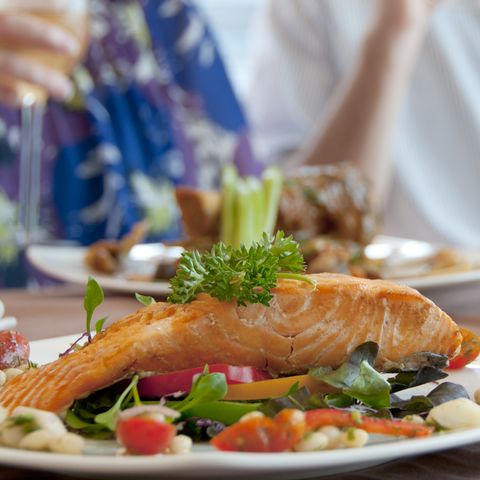Vitamin D3 is one of those in-the-weeds nutrients—a nutrient you sort of stumble upon during deep discussions with your doctor (if you’re fortunate enough to have that kind of doctor) or during internet rabbit holes (probably more likely).
And vitamins like D3 tend to bring up a whole host of questions. What exactly is vitamin D3? How does vitamin D3 different than regular ol’ vitamin D? Where do you get vitamin D3? And what’s the difference between D&D and D3? (Last one is easy: the first is an immersive experiential game.) As for the rest? Let’s start with the basics.
“Vitamin D3 (cholecalciferol) is a nutrient that’s made in the body when the skin is exposed to sunlight. It can also be found in animal flesh, fish oil, and fortified foods,” says Kim Yawitz, a registered dietitian and gym owner in St. Louis, Mo.
Vitamin D3 is best known for strengthening your bones, which it does by helping the body absorb calcium and phosphorus from food, Yawitz says. “But it also reduces inflammation, boosts the immune system, promotes heart health, and serves other important functions in the body,” she says.
While some nutrients have a “recommended dietary allowance” (RDA), there’s no established guideline for vitamin D3, specifically, says Yawitz. That said: “Men should aim for 600 international units (IU) of vitamin D per day, which can come from vitamin D2, vitamin D3, or a combination of both,” she says.
Because D3 is more easily absorbed than D2, and it also remains in the body longer than D2. “And so, you may be able to get a bit more bang for your buck by choosing foods that are naturally high in vitamin D3,” says Yawitz.
Before we dive into signs of vitamin D3 deficiencies, the best sources of vitamin D3, and more, there is one more important thing to keep in mind: “Vitamin D3 is fat-soluble, which means that you can enhance its absorption by taking it with foods that have a bit of healthy fat,” says Yawitz, adding that this is especially true for supplements and may also be beneficial for food sources of D3 that are naturally low in fat.
What are signs of a D3 deficiency?
Vitamin D may be “the sunshine vitamin,” but you can also get it from your diet.
Either way, most Americans are not getting enough of vitamin D. “By some estimates, more than 90 percent of American men don’t get enough vitamin D in their diets. But that doesn’t necessarily mean they’re deficient,” says Yawitz. “Your body makes vitamin D3 when your skin is exposed to sunshine. So even if you don’t eat a lot of foods that are naturally high in D3, your D levels could be fine if you regularly spend even a few minutes in direct sunlight.”
And a true vitamin D3 deficiency can be difficult to identify, simply because there aren’t a lot of easy-to-spot symptoms. “Severe deficiency can lead to osteomalacia—a condition that causes weak and painful bones and sometimes dental issues,” she says.
”One large study also found that people with low vitamin D levels are more likely to experience depression. However, depression alone isn’t a good indicator of low vitamin D3 status.”
What foods are high in vitamin D3?
There’s a host of food sources that are good or excellent sources of vitamin D3.
Here are some of Yawitz’s top recommendations:
- Cod liver oil: “Coming in at 1,360 IU per tablespoon, cod liver oil is the best dietary source of vitamin D3 by far,” says Yawitz. Try adding it into a shot of juice like OJ or tart cherry juice if you don’t want to chase it straight.
- Rainbow trout: If you don’t eat it already, it’s time to add this nutrient-dense fish to your diet. “Three ounces of rainbow trout provide 645 IU of vitamin D3, plus 17 grams of muscle-building protein,” says Yawitz.
- Salmon: “Three ounces of salmon will get you pretty close to your daily D3 quota (570 IU, to be exact) and can also help protect your heart if you have heart disease risk factors,” says Yawtiz, adding that according to a 2021 study, eating 12 ounces of salmon or other fatty fish each week could lower your risk of heart attack and stroke by about 17 percent.
- Milk: “One cup of 2% milk provides 120 IU of vitamin D, usually in the form of D3. Adding a glass each morning can help protect your teeth and bones, especially as you age,” says said.
Is taking a vitamin D3 supplement a good idea?
Vitamin D3 supplements aren’t for everyone, but they may be a good idea for some people.
“A vitamin D3 supplement could be beneficial if you’re vegan or lactose intolerant, if you have dark skin, if you don’t get a lot of sun, or if you have certain medical conditions,” says Yawitz. “That being said, it’s always best to talk with your doctor before starting any supplement.”
As she points out, taking high doses of vitamin D3 can lead to nausea, vomiting, diarrhea, muscle weakness, dehydration, kidney stones, kidney failure, irregular heartbeat, and other health problems. Again, talking to a medical professional can help you determine if a vitamin D3 supplement may be right for you.
This content is created and maintained by a third party, and imported onto this page to help users provide their email addresses. You may be able to find more information about this and similar content at piano.io









